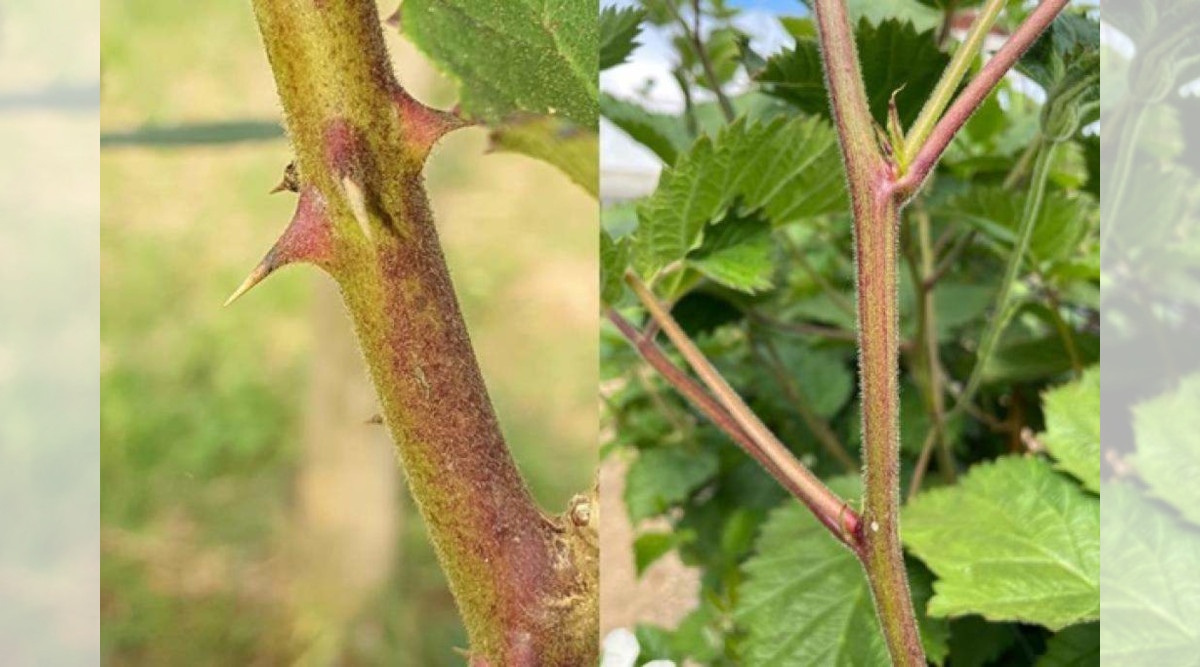BREEDING WORK …Breakthrough offers roadmap for development of other ‘thornless’ plants
Scientists’ pinpointing of the genetic locus for blackberry’s thorny trait is a step toward more efficient selection for thornlessness. (Photos courtesy of Ellen Thompson, Global Rubus Breeding and Development Director for Hortifrut Genetics)
WASHINGTON — With support from the USDA’s National Institute of Food and Agriculture through the Specialty Crop Research Initiative and the Agriculture and Food Research Initiative, scientists have pinpointed the location on a chromosome that carries the gene behind thornless blackberries.
“This is the first diagnostic marker for any trait that’s been developed and published in blackberry,” said Project Leader Dr. Margaret Worthington, who leads fruit breeding and genetics for the Arkansas Agricultural Experiment Station, the research arm of the University of Arkansas System Division of Agriculture.
Welcome News for Breeders and Growers
It’s welcome news for breeders who have chased the thorn-free trait for decades without a road map. Progress has been slow because the main thorn-free trait came from a recessive gene hidden within a plant that carries four copies of every chromosome.
“No one knew the genetic locus for the prickly trait,” Worthington said. Finding it became “an obvious target to work on” when she began tackling the problem in 2016.
In 2017 (the last year data were reported by USDA’s National Agricultural Statistics Service), blackberries were grown on 6,300 acres, mostly in Oregon, with a utilized production value of $31.3 million and more than 40 million pounds consumed either fresh or frozen in the United States.
For growers, prickles have long been more than a nuisance. They can break off and hide among harvested berries, pose food safety risks, scrape neighboring fruit and force workers to wear thick gloves, driving up labor costs.
Worthington’s team scanned the genomes of more than 300 varieties and breeding selections and narrowed thornlessness to a 6-million-base-pair stretch at the tip of chromosome four. Knowing the approximate address allowed scientists to craft three rapid DNA tests or KASP markers, that are highly predictive of whether a greenhouse seedling will ever grow thorns.
Study co-author Dr. Ellen Thompson with Hortifrut Genetics called the genetic tools a watershed moment. “These are the world’s first publicly available markers developed for fresh-market and processing blackberries,” she said. “Markers save time and money, allowing breeders to make decisions faster—before seedlings are planted in the field.”
Because Hortifrut’s program is already fully thornless, Thompson is eager to use the tests in the opposite direction: screening offspring from thorny, rustic parents for the few seedlings that combine exotic traits, such as drought hardiness, with a smooth stem.
Discovery Results in Dramatic Efficiency Gains
The efficiency gains are dramatic. A commercial breeding program might sow 10,000 seedlings a year, only to discard most once the canes mature and reveal their thorns. With the new test, those culls happen in a petri dish, freeing vast stretches of field space and cutting years off the timeline.
Hudson Ashrafi, a collaborator on the project and an associate professor from North Carolina State University, said knowing the thornless locus lets breeders avoid waiting to phenotype mature canes, which “reduces breeding cycle length … and improves selection efficiency for thornless blackberries.”
Smooth canes also mean fewer micro-scratches on berry skin, which slows mold, extends shelf life and eases long-distance shipping. U-pick farms can invite guests without worrying about children leaving with scratched forearms, and producers in humid regions may rely less on fungicides because intact berry skin blocks infection.
Biologically, the work illuminates how a seemingly simple feature—skin-deep prickles—links to complex genetics. The researchers detected a “linkage disequilibrium block” around the thornless gene: a region where neighboring genes travel together.
Over the years, intense selection for smooth canes dragged along less desirable companions such as high acidity and floppy growth. By identifying precise markers, breeders can now hunt for rare plants that keep the smooth gene but shuffle the rest of the deck, breaking those old linkages.
The method is already rippling outward. Roses, raspberries and even some citrus species struggle with prickles or thorns and share comparable, multi-copy genomes. The software and lab pipelines refined in this study offer a roadmap for those crops, promising thorn-free bouquets and scratch-less orange groves in the not-too-distant future.
For more information on this research, see “Research Team Homes in on Genetics Behind Blackberry Thorns.”
—Lori Tyler Gula, Senior Public Affairs Specialist
USDA NIFA
